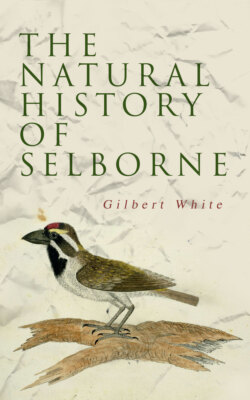Читать книгу The Natural History of Selborne - Gilbert White - Страница 6
На сайте Литреса книга снята с продажи.
ОглавлениеLETTERS ADDRESSED TO THOMAS PENNANT, ESQ.
Table of Contents
LETTER I.
Table of Contents
The parish of Selborne lies in the extreme eastern corner of the county of Hampshire, bordering on the county of Sussex, and not far from the county of Surrey; is about fifty miles south-west of London, in latitude fifty-one, and near mid-way between the towns of Alton and Petersfield. Being very large and extensive, it abuts on twelve parishes, two of which are in Sussex, viz., Trotton and Rogate. If you begin from the south and proceed westward, the adjacent parishes are Emshot, Newton Valence, Faringdon, Hartley Mauduit, Great Ward le Ham, Kingsley, Hadleigh, Bramshot, Trotton, Rogate, Lyffe, and Greatham. The soils of this district are almost as various and diversified as the views and aspects. The high part of the south-west consists of a vast hill of chalk, rising three hundred feet above the village, and is divided into a sheep-down, the high wood and a long hanging wood, called The Hanger. The covert of this eminence is altogether beech, the most lovely of all forest trees, whether we consider its smooth rind or bark, its glossy foliage, or graceful pendulous boughs. The down, or sheep-walk, is a pleasing, park-like spot, of about one mile by half that space, jutting out on the verge of the hill-country, where it begins to break down into the plains, and commanding a very engaging view, being an assemblage of hill, dale, wood-lands, heath, and water. The prospect is bounded to the south-east and east by the vast range of mountains called the Sussex Downs, by Guild-down near Guildford, and by the Downs round Dorking, and Ryegate in Surrey, to the north-east, which altogether, with the country beyond Alton and Farnham, form a noble and extensive outline.
At the foot of this hill, one stage or step from the uplands, lies the village, which consists of one single straggling street, three-quarters of a mile in length, in a sheltered vale, and running parallel with the Hanger. The houses are divided from the hill by a vein of stiff clay (good wheat land), yet stand on a rock of white stone, little in appearance removed from chalk; but seems so far from being calcareous, that it endures extreme heat. Yet that the freestone still preserves somewhat that is analogous to chalk, is plain from the beeches, which descend as low as those rocks extend, and no farther, and thrive as well on them, where the ground is steep, as on the chalks.
The cart-way of the village divides, in a remarkable manner, two very incongruous soils. To the south-west is a rank clay, that requires the labour of years to render it mellow; while the gardens to the north-east, and small enclosures behind, consist of a warm, forward, crumbling mould, called black malm, which seems highly saturated with vegetable and animal manure; and these may perhaps have been the original site of the town; while the woods and coverts might extend down to the opposite bank.
At each end of the village, which runs from south-east to north-west, arises a small rivulet: that at the north-west end frequently fails; but the other is a fine perennial spring, little influenced by drought or wet seasons, called Well-head. This breaks out of some high grounds joining to Nore Hill, a noble chalk promontory, remarkable for sending forth two streams into two different seas. The one to the south becomes a branch of the Arun, running to Arundel, and so sailing into the British Channel: the other to the north. The Selborne stream makes one branch of the Wey; and, meeting the Black-down stream at Hadleigh, and the Alton and Farnham stream at Tilford-bridge, swells into a considerable river, navigable at Godalming; from whence it passes to Guildford, and so into the Thames at Weybridge; and thus at the Nore into the German Ocean.
Our wells, at an average, run to about sixty-three foot, and when sunk to that depth seldom fail; but produce a fine limpid water, soft to the taste, and much commended by those who drink the pure element, but which does not lather well with soap.
To the north-west, north and east of the village, is a range of fair enclosures, consisting of what is called a white malm, a sort of rotten or rubble stone, which, when turned up to the frost and rain, moulders to pieces, and becomes manure to itself.
Still on to the north-east, and a step lower, is a kind of white land, neither chalk nor clay, neither fit for pasture nor for the plough, yet kindly for hops, which root deep in the freestone, and have their poles and wood for charcoal growing just at hand. The white soil produces the brightest hops.
As the parish still inclines down towards Wolmer Forest, at the juncture of the clays and sand the soil becomes a wet, sandy loam, remarkable for timber, and infamous for roads. The oaks of Temple and Black-moor stand high in the estimation of purveyors, and have furnished much naval timber; while the trees on the freestone grow large, but are what workmen call shaky, and so brittle as often to fall to pieces in sawing. Beyond the sandy loam the soil becomes a hungry, lean sand, till it mingles with the forest; and will produce little without the assistance of lime and turnips.
